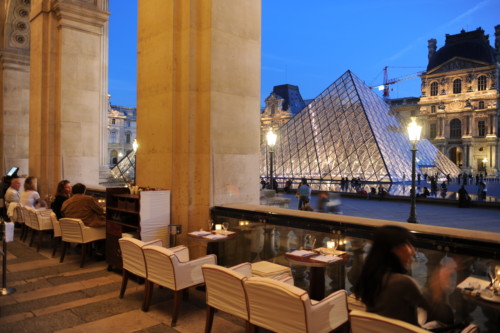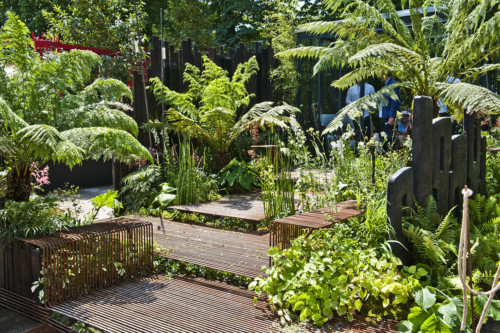
Where To Eat, Drink, & Smell The Roses Around The Tuileries
Set in the very heart of Paris between Place de la Concorde and the Louvre, Jardins Jardin’s 14th edition just closed its doors. This year, some of Paris’s best landscape artists invested the city’s oldest Jardins à la Française. Imagined by Catherine de Médicis, it was reinvented in the XVIIth Century by the great Le Nôtre (the mastermind behind Louis XIV’s Versailles gardens) and transformed for a few days into a reflection of one of France’s most prized destinations.
This year’s theme was “The Nature City”– a theme honoring both the bicentenary of the birth of Jean-Charles-Adolphe Alphand (a great landscape artist born in 1817) that also acknowledges the ongoing awareness that cities all over the world have with respect to environmental affairs– now more than ever, global cities like Paris aim to integrate more and more greenery to their urban design.
Dreaming of an idyllic “green” city that is as attractive as it is authentic, the show attempted to demonstrate that putting the environmental challenges of our times at the heart of garden design is not only possible, but a conduit for inventiveness and creativity.

Vallois

Vallois

Copacabanon

Copacabanon

Copacabanon

Horticulture Et Jardins

Jardin De Gally

Jardin De Gally

Horticulture Et Jardins

Copacabanon

Brimoncourt
After last year’s very humid edition (the Seine had, after days of continuous rain, experienced an exceptional flood), this year’s Jardins Jardin appeared as an enjoyable contrast, the warm sun a perfect prelude to a summer day in the garden. With 11 landscape artists, 20 staged terraces, and over 100 exhibitors, Jardins Jardin once again used its programming to raise awareness about the great art of landscaping and the major role our cities can play in the future of our planet.
If you missed this year’s edition, scroll through the slideshow above to see a few of our favorite concepts, and scroll through our list of favorite places to eat, drink, and smell the roses in and around the Tuileries.
Our Must-See Favorites Around the Tuileries
La Pâtisserie des Tuileries
The second location opened by the famous pastry chef Sebastien Gaudard, La Pâtisserie des Tuileries is ideally located under the welcoming arcades of the Rue de Rivoli. With its quaint majesty and Parisian charm, it’s the perfect spot for an afternoon cup of tea, with an extensive selection of rare blends from all over the world. Paired with one of the place’s unrivaled pâtisseries, a trip to the Tuileries wouldn’t be complete without it. The classic chocolate eclair and lemon tart are both flawlessly executed.
La Pâtisserie des Tuileries is located at 1 Rue des Pyramides, Paris 1er.
Le Café Marly
Perfectly situated on the premises of the Louvre, Café Marly is an ideal spot for lunch or dinner post-Jardins Jardin. Located in the galleries of the Cour Carrée, it is one of the city’s most iconic restaurants. For the ultimate “Marly” experience, choose a table on the terrace and enjoy a view of the Napoleon III part of the palace– and I. M. Pei’s incredible, iconic glass pyramid. On the menu, enjoy a range of typical French dishes such as Foie Gras or Beef Tartare, mixed with subtle fusion food and international brasserie musts such as the Marly Cheeseburger with Iberico bacon. Reservation is highly recommended– and if you’re in Paris during Fashion Week, just forget it.
Le Café Marly is located at 93 rue de Rivoli, Paris 1er.
Angelina Paris
Angelina’s hot chocolate is largely regarded as one of the best hot chocolates in Paris, taking the greatness of what is already an excellent beverage into a new dimension. Founded in 1903 and offering sublime Belle Epoque decor, this salon de thé is a real institution. Angelina’s African hot chocolate is made of a special, secret blend of three cocoas from Niger, Ghana, and Cote d’Ivoire, resulting in what we promise will be a life-altering experience. For the Real Deal (forget the calories, remember: you are in Paris!), pair it with the House’s Mont-Blanc– a decadent pastry combining chestnut cream, whipped cream, and meringue.
Angelina Paris is located at 266 rue de Rivoli, Paris 1er.
Highlights From Jardins Jardin 2017
Didier Danet SA
Starting his company in the early 1980s, the landscape architect Didier Danet has built a team with a very broad range of skills. This knowledge inspired “Low Impact”– the installation he presented at this year’s expo. Danet’s premise was this: If the XXth century was all about mastering nature, the XXIst must become about reducing our impact on it. 80% of the total surface within his installation was dedicated to lush, wild plants that aimed to reconcile Humankind with Nature in order to achieve a sweet symbiosis. In Danet’s cosmology, Man invites Nature into his universe and enjoys it without disrupting it.
Brimoncourt
The only Champagne House present this year, Brimoncourt offered a garden named the Embarquement pour Cythère (“Boarding for Kythera” in French)– a nod at the mythical ancient island and a creation signed by landscape architect Alexandre Tonnerre as a tribute to Antoine Watteau’s painting, “Pilgrimage to Kythera”, painted in 1717. Odiferous and mediterranean plants were primary, some of them cast in bright red iron sculptures that reminisce of ancient civilization. Of course, there was a bar, surrounded by star jasmine.
Copacabanon
It’s only been a year since young architect Nelson Wilmotte launched his brand of eco-responsible garden sheds, Copacabanon (a play on the French word cabanon, meaning “hut”, and Copacabana). Made exclusively in France with eco-certified spruce wood from the Jura mountains, the concept is finding its way into the homes of concerned esthetes. With its Kobe model, the brand paired with Les Jardins de Gally to present a modern version of the “wild sanctuary” ideal. Almost hidden by perennials and grasses, the Kobe shed (made with burnt wood according to the ancestral tradition of Japanese Shou-sugi-ban) represented the pinnacle of modern shelter.
Horticulture & Jardins
Every year, the talented Pierre-Alexandre Risser– one of the founding members of the Jardins Jardin non-profit– fascinates guests with mesmerizing creations. With “Ciel, mon Jardin!” (“Heaven, my garden!”), he delivered another astonishing performance. To celebrate the 30th anniversary of his company, Horticulture & Jardins, Risser created a vertical garden on the base of a scaffolding frame, entirely recovered with plants. With star jasmine (again) dressing the structure, the exhibit was erected as a true Temple of Nature. (The first floor offered an incredible perspective on the show, as the very top of the structure was mounted with mirrors, reflecting both the chestnut trees and the sky.)
Les Jardins de Gally
Another founding member of the show, Les Jardins de Gally, presented the intriguing “La Fabrique fertile” (“the fertile mill”), which gathered enlightened professionals and neophytes around a concise expression of biodiversity. From the greenhouse where exotic plants grow to the domesticated landscape, the gardener takes care of the soil, which rewards him a hundredfold. Nature spreads its wings, happily pervading the walls and creating a world where mineral and vegetable mix– where Nature becomes Art.
Want more Paris reccomendations? Check out the REcyclerie, or peruse our list of The Most Romantic Hotels in Paris.

















































